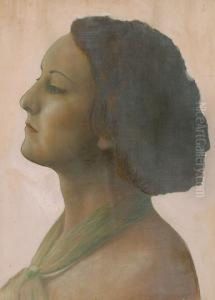Geza Szontagh Paintings
Geza Szontagh was a Hungarian painter born in 1856, known for his contributions to landscape painting, an art form that he pursued with a distinct passion and sensitivity towards the natural world. His life and career were rooted in the Austro-Hungarian Empire, a context that provided rich cultural and natural landscapes for his artistic endeavors. Szontagh's work is often characterized by a keen observation of natural beauty, rendered with a meticulous attention to light and color, elements that became hallmarks of his artistic style.
Szontagh's journey into the world of art began at an early age, influenced by the rich artistic traditions of Hungary and the broader Austro-Hungarian region. He pursued formal art education in some of the most prestigious art academies of the time, which helped him refine his skills and develop a distinctive approach to landscape painting. Throughout his career, Szontagh was deeply inspired by the landscapes of Hungary and the surrounding regions, often depicting scenes of rural life, forests, rivers, and mountains with a poignant sense of realism and emotional depth.
Despite the challenges of his era, including the tumultuous social and political changes sweeping through Europe at the turn of the 20th century, Szontagh remained dedicated to his art. His works were widely exhibited and garnered admiration for their beauty and technical proficiency. Szontagh's contribution to Hungarian art was not only in his paintings but also in his influence on younger generations of artists, as he was known to be a supportive mentor to emerging talents.
Geza Szontagh's life came to an end in 1918, amidst the upheaval of World War I and the subsequent dissolution of the Austro-Hungarian Empire. His death marked the loss of a significant figure in Hungarian art, but his legacy lived on through his paintings, which continue to be celebrated for their artistic merit and historical significance. Szontagh's work is a testament to the enduring beauty of the natural world and the ability of art to capture and convey the profound emotions it inspires.


